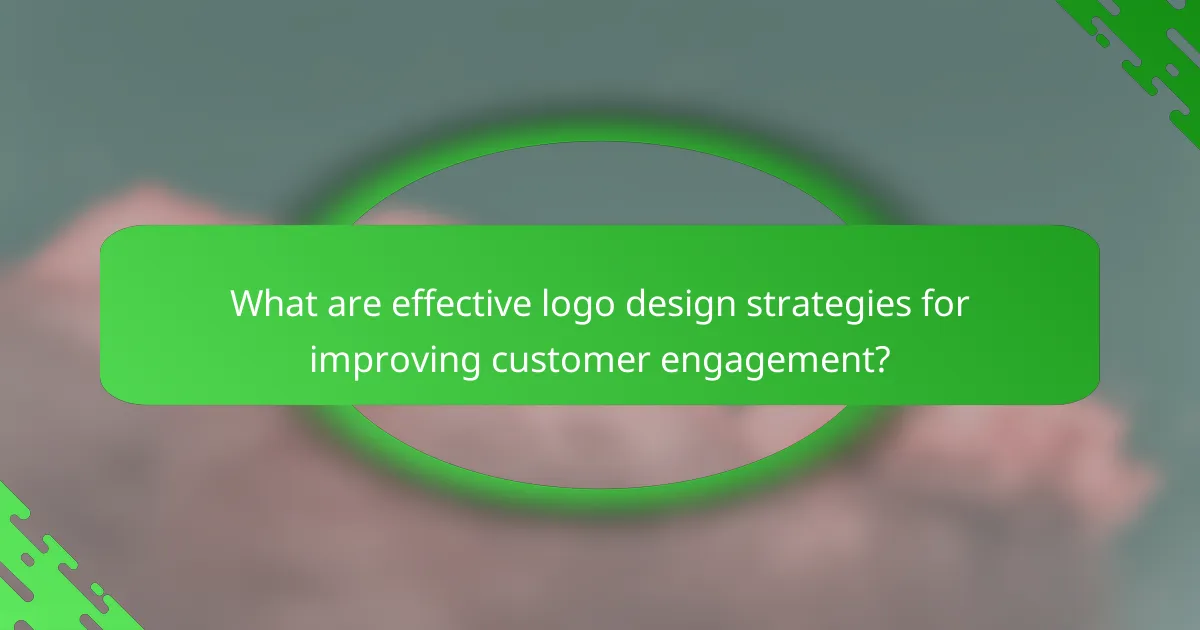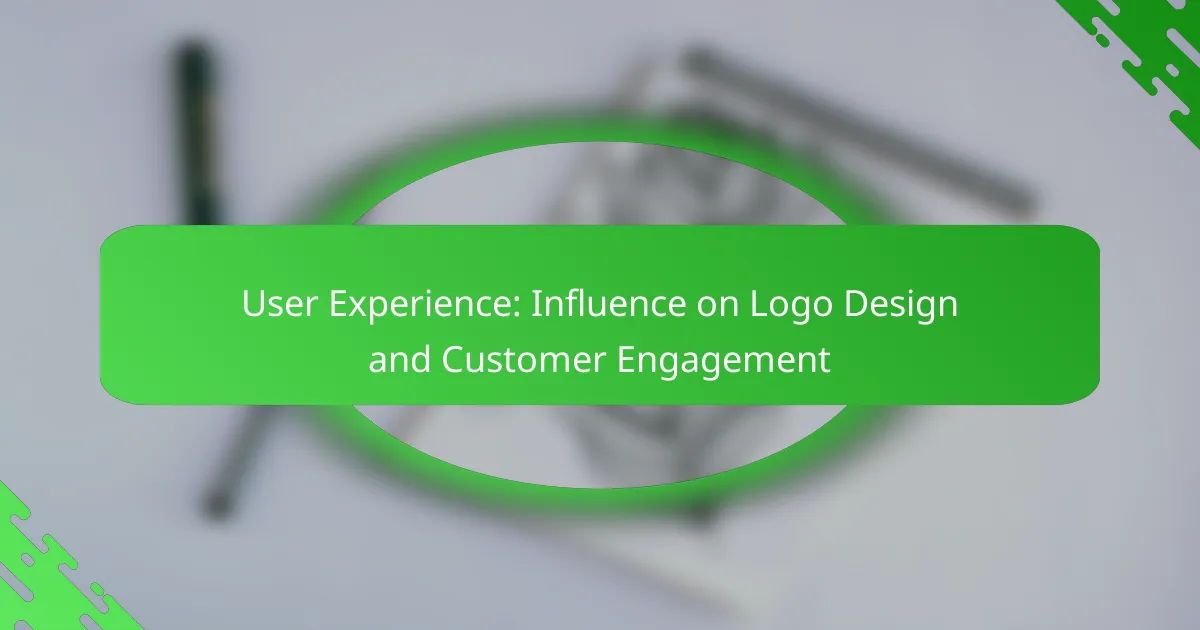User experience plays a crucial role in logo design, influencing how customers perceive and engage with a brand. A thoughtfully crafted logo not only enhances usability but also fosters emotional connections, leading to increased customer loyalty and engagement. By leveraging design strategies that consider color psychology and user feedback, businesses can create logos that resonate with their audience and drive meaningful interactions.

How does user experience influence logo design in e-commerce?
User experience significantly impacts logo design in e-commerce by shaping how customers perceive and interact with a brand. A well-designed logo enhances usability and fosters a positive emotional connection, ultimately driving customer engagement and loyalty.
Visual appeal enhances brand recognition
A visually appealing logo is crucial for brand recognition in e-commerce. It should be distinctive, memorable, and aligned with the brand’s identity. For instance, using bold colors and unique shapes can help a logo stand out in a crowded marketplace.
Consider the simplicity of logos like Apple or Nike; their designs are not only attractive but also easily recognizable. Aim for a logo that can be identified at a glance, even when displayed in smaller sizes, such as on mobile devices.
Intuitive design fosters customer trust
An intuitive logo design contributes to customer trust by conveying professionalism and reliability. Logos that are cluttered or overly complex can confuse potential customers, leading to skepticism about the brand’s credibility.
Ensure that your logo reflects the values and mission of your e-commerce business. For example, a tech company might opt for a sleek, modern design, while a handmade goods store could choose a more rustic and organic look. Consistency in design across all platforms reinforces trust.
Responsive logos improve engagement
Responsive logos adapt to different screen sizes and formats, enhancing user experience and engagement. As more consumers shop on mobile devices, logos must be versatile enough to maintain clarity and impact across various platforms.
Design a logo that can be simplified or adjusted for smaller screens without losing its essence. For example, the full logo might include text on a desktop site, while a simplified icon version could be used for mobile apps. This adaptability ensures that your brand remains recognizable regardless of the device.

What are effective logo design strategies for improving customer engagement?
Effective logo design strategies focus on creating a strong emotional connection with customers, enhancing brand recognition, and fostering loyalty. By considering elements like color psychology, user feedback, and adaptable variations, businesses can significantly boost customer engagement through their logos.
Utilizing color psychology
Color psychology plays a crucial role in logo design as different colors evoke specific emotions and perceptions. For instance, blue often conveys trust and reliability, while red can evoke excitement and urgency. Choosing the right color palette can enhance customer engagement by aligning the brand’s message with the emotional responses of the target audience.
When selecting colors, consider cultural implications as well. For example, while white symbolizes purity in many Western cultures, it may represent mourning in some Eastern cultures. Testing color combinations with focus groups can provide insights into how your audience perceives your logo.
Incorporating user feedback
Gathering user feedback is essential for refining logo designs and ensuring they resonate with the intended audience. Conduct surveys or focus groups to collect opinions on various logo concepts, asking participants what emotions or thoughts the designs evoke. This direct input can guide adjustments that enhance engagement.
Additionally, A/B testing different logo versions in real-world settings can reveal which design elements attract more attention and foster a stronger connection. Be open to iterating based on feedback to create a logo that truly reflects customer preferences.
Creating adaptable logo variations
Adaptable logo variations are vital for maintaining brand consistency across different platforms and applications. A primary logo may work well on a website, while a simplified version might be better suited for social media profiles or mobile apps. Ensuring your logo is versatile allows for greater visibility and recognition in various contexts.
When designing variations, consider the size and format in which the logo will be displayed. For example, a logo should remain legible and recognizable at small sizes, such as on business cards or promotional materials. Creating a style guide that outlines usage rules for each variation can help maintain brand integrity.

How can businesses measure the impact of logo design on user experience?
Businesses can measure the impact of logo design on user experience by analyzing customer behavior, conducting tests, and gathering feedback. These methods provide insights into how a logo influences customer perceptions and engagement.
Analyzing customer retention rates
Customer retention rates can indicate how effectively a logo resonates with the target audience. A strong logo may lead to higher retention, as it fosters brand recognition and loyalty. Businesses should track retention over time, comparing periods before and after a logo change to assess its impact.
For example, if a company sees a retention increase from 60% to 75% after a logo redesign, it suggests that the new design positively influences customer experience. Regularly monitoring these rates can help identify trends related to logo effectiveness.
Conducting A/B testing on logo variations
A/B testing involves presenting different logo designs to segments of the audience to determine which version performs better. This method allows businesses to gather data on user preferences and engagement levels with each logo. Metrics such as click-through rates and conversion rates can provide valuable insights.
For instance, if one logo variant results in a 15% higher click-through rate compared to another, it indicates a stronger connection with users. Businesses should ensure that tests run for a sufficient duration to gather reliable data, typically a few weeks.
Gathering user surveys and feedback
User surveys and feedback are essential for understanding how a logo impacts customer perceptions. By asking targeted questions about the logo’s appeal, memorability, and association with the brand, businesses can gain qualitative insights. Surveys can be distributed through email, social media, or directly on websites.
Incorporating open-ended questions allows customers to express their thoughts freely, providing deeper insights into their experiences. Regularly collecting feedback after a logo change can help businesses make informed adjustments to enhance user experience further.

What role does branding play in user experience and logo design?
Branding is crucial in shaping user experience and logo design, as it establishes a company’s identity and influences customer perceptions. A well-crafted brand not only attracts attention but also fosters trust and recognition, which are essential for customer engagement.
Consistency reinforces brand identity
Consistency in branding ensures that all visual elements, including logos, colors, and typography, align across various platforms. This uniformity helps customers easily recognize the brand, enhancing their overall experience. For example, using the same logo and color scheme on a website, social media, and packaging creates a cohesive identity that strengthens brand recall.
To maintain consistency, develop brand guidelines that outline how elements should be used. This includes specifications for logo placement, font choices, and color palettes. Regular audits of marketing materials can help identify any inconsistencies that may confuse customers.
Emotional connection drives customer loyalty
Creating an emotional connection through branding can significantly enhance customer loyalty. When customers feel a personal attachment to a brand, they are more likely to choose it over competitors. This connection can be fostered through storytelling, relatable messaging, and engaging visuals that resonate with the target audience.
For instance, brands that share their values or mission often attract customers who identify with those principles. Incorporating customer feedback into branding efforts can also strengthen this bond, as it shows that the brand values its audience’s opinions and experiences.

What are the emerging trends in logo design for enhancing user experience?
Emerging trends in logo design focus on improving user experience by prioritizing clarity, personalization, and sustainability. These trends help brands connect with their audience more effectively, fostering engagement and loyalty.
Minimalist designs for clarity
Minimalist logo designs emphasize simplicity and clarity, making them easily recognizable and memorable. By stripping away unnecessary elements, brands can communicate their core message quickly, which is essential in a fast-paced digital environment.
Consider using a limited color palette and straightforward typography to enhance legibility. For example, companies like Apple and Nike effectively use minimalist logos that resonate with a broad audience, reinforcing brand identity without overwhelming viewers.
Dynamic logos for personalization
Dynamic logos adapt to user interactions or contexts, creating a personalized experience that engages customers. This trend allows brands to connect on a deeper level by reflecting user preferences or behaviors, enhancing emotional resonance.
For instance, Google frequently updates its logo to celebrate events or holidays, making it relevant to users. Brands can explore dynamic elements, such as animated logos or customizable features, to foster a sense of ownership among their audience.
Eco-friendly branding elements
Incorporating eco-friendly elements into logo design reflects a brand’s commitment to sustainability, appealing to environmentally conscious consumers. This trend can involve using natural colors, organic shapes, or symbols that represent eco-friendliness.
For example, brands like Patagonia utilize earthy tones and nature-inspired designs to communicate their environmental values. When designing logos, consider integrating sustainable practices, such as using recycled materials for physical branding or promoting eco-friendly initiatives, to strengthen your brand’s image.



